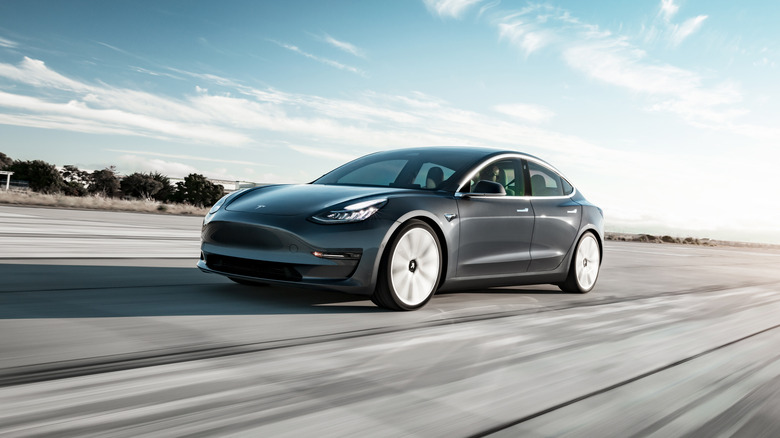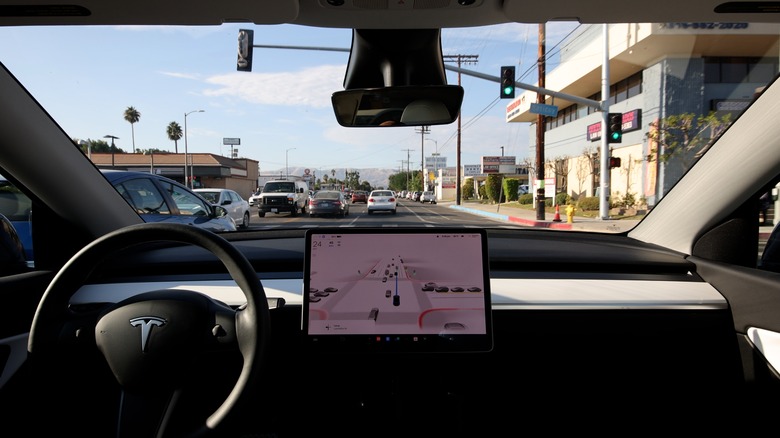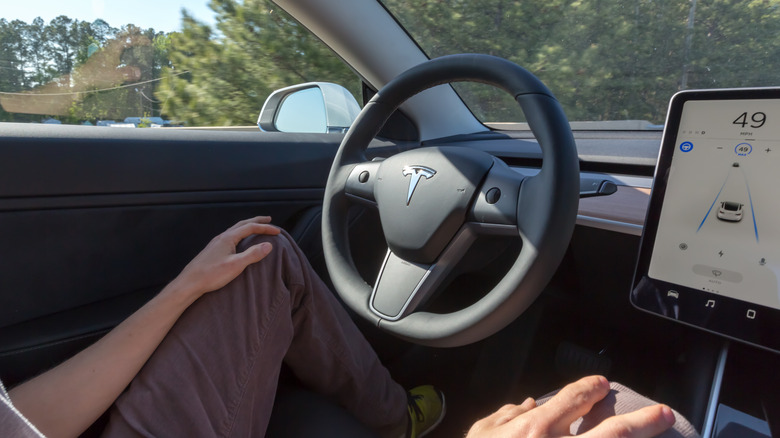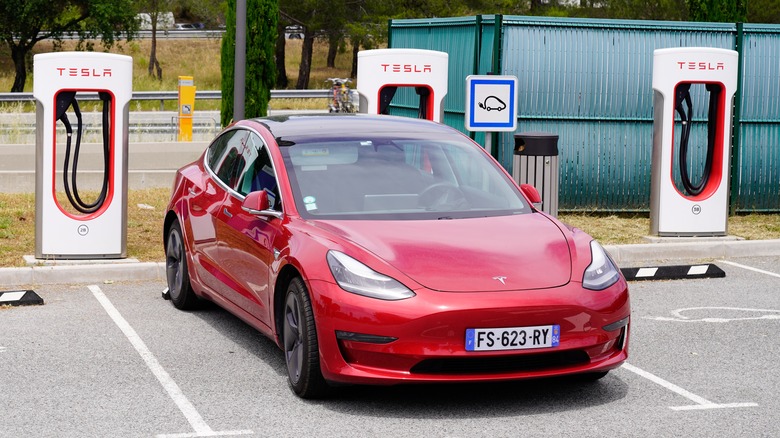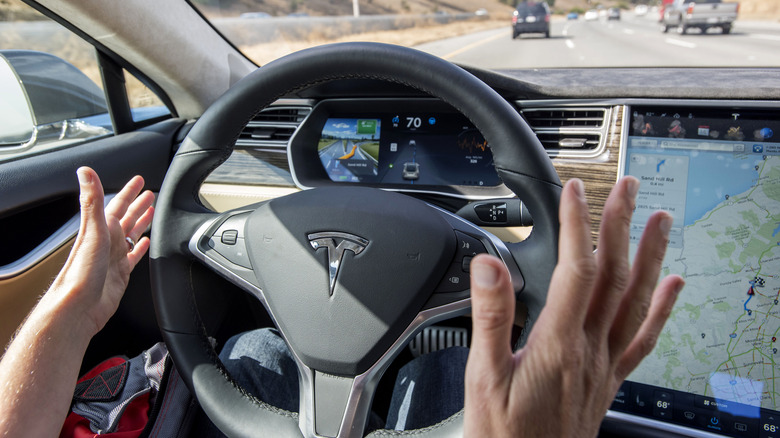How To Turn On Autopilot In A Tesla Model 3
Tesla cars have been fitted with an advanced driver-assistance system (ADAS) called "Autopilot" since 2014. There have been several hardware revisions over the nine years since, and while a fully autonomous system has been promised repeatedly (reports The Verge), such functionality isn't yet available.
For now, and until both technology and legislation allow, Autopilot should be seen as an advanced driver assistance system. This is what Tesla itself describes Autopilot as, adding it "enhances safety and convenience behind the wheel ... When used properly, Autopilot reduces your overall workload as a driver."
There have been several generations of Autopilot, with many software upgrades for drivers to install in order to give their car the latest features. As of early 2023, Tesla says new cars are equipped with eight external cameras and "powerful vision processing to provide an additional layer of safety."
All Tesla cars built for the North American market all come with the company's camera-based Tesla Vision system. In Europe and Middle Eastern markets, only the Model 3 and Model Y come with Tesla Vision, says Tesla.
Three Autopilot packages
As of January 2023, Autopilot is split into three distinct packages. The standard version of Autopilot is fitted to all new Tesla cars and provides two main functions: these are called Traffic-Aware Cruise Control, which matches the speed of your car to the vehicle ahead while maintaining a safe gap, and Autosteer, which keeps the car in its lane when the Tesla Vision system can clearly see the lane markings.
Above this version is Enhanced Autopilot. This costs $6,000 at the time of writing, and includes functions called Navigate on Autopilot, Auto Lane Change, Autopark, Summon and Smart Summon. These features use cruise control and lane-keep steering to guide the car from a highway on-ramp to the off-ramp, suggest lane changes, navigate interchanges, engage the turn signal and take the correct exit.
The system also helps to park the car in compatible spaces, and lets you move the car in or out of a tight space using the Tesla smartphone app. Smart Summon guides the car around "complex environments and parking spaces," Tesla says, to find you in a parking lot. Summon and Smart Summon are to only be used on private land, like parking lots and driveways, within 200 feet and only when the car is in your line of sight.
Lastly, Full Self-Driving Capability costs $15,000, and adds the ability to respond to traffic lights and stop signs (albeit in an unfinished, beta form). As of January 2023, Tesla says "Autosteer on city streets" is coming soon.
Turning on Autopilot
When engaging Autopilot for the first time, the driver must agree to a message on the touchscreen display. This message states they must "keep your hands on the steering wheel at all times" and always "maintain control and responsibility for your vehicle." Subsequently, every time Autopilot is engaged the driver is reminded to "keep your hands on the wheel."
To engage Traffic-Aware Cruise Control in a Tesla Model 3:
-
When driving, pull down once on the gear selector stalk on the right of the steering column
To engage Autosteer in a Tesla Model 3:
-
When driving, pull down twice on the gear selector stalk. A gray steering wheel icon appears next to the speedometer, turning blue when Autosteer is engaged. If the car cannot see lane markings on the road, the icon will turn gray and Autosteer is disabled.
To engage Navigate on Autopilot in a Tesla Model 3:
-
While parked, enable Autosteer by going to Settings -> Controls -> Autopilot -> Autosteer, then tap to enable Navigate on Autosteer.
-
On compatible routes, tap the Navigate on Autopilot button in the Navigation Turn List, or move the gear lever downwards twice in quick succession while driving on a compatible route.
To engage Auto Lane Change in a Tesla Model 3:
-
While parked, go to Settings -> Controls -> Autopilot -> Auto Lane Changes
-
When using Autosteer, engage the turn signal
-
Confirm the lane change request
Using Autopark and Summon
To engage Autopark in a Tesla Model 3:
-
Drive below 15 mph to detect a parallel parking space, or below 10 mph to detect a perpendicular space.
-
Once your car spots a space, a gray 'P' icon will appear on the instrument panel.
-
Press the brake pedal.
-
Shift to reverse.
-
Press "Start Autopark" on the display.
-
Release the brake and steering wheel.
To engage Summon in a Tesla Model 3:
-
Open the Tesla smartphone app.
-
Tap "Summon."
-
Press the forwards or reverse buttons to move your car in that direction.
-
Let go to stop the car.
To engage Smart Summon in a Tesla Model 3:
-
Open the Tesla smartphone app.
-
Tap Summon.
-
Tap the Smart Summon icon.
-
Press and hold the "Come To Me" button, or tap the target icon, set the target destination by adjusting the map, and then hold the "Go To target" button.
-
Release either button to stop the car.
To engage Light and Stop Sign Control (beta) in a Tesla Model 3:
-
Shift to park and tap Controls -> Autopilot -> Traffic Light and Stop Sign Control (Beta).
-
Engage Traffic-Aware Cruise Control or Autosteer.
-
The car display now indicates upcoming traffic lights and stop signs.
-
To set off from a stop sign, pull the Autopilot stalk or briefly press the accelerator.
Is Autopilot autonomous?
Autopilot is a driver assistance system, so Tesla cars are not fully autonomous. Tesla explains that, while all of its new cars come with Autopilot installed, even the upgrade called Full Self-Driving Capability is not capable of driving the car by itself. The company says the systems are "intended for use with a fully attentive driver, who has their hands on the wheel and is prepared to take over at any moment."
Tesla adds: "While these features are designed to become more capable over time, the current enabled features do not make the vehicle autonomous."
With regard to the car's active safety features, like automatic emergency braking, side collision warning and lane departure avoidance, Tesla tells drivers: "Active safety features are designed to assist drivers, but cannot respond in every situation. It is your responsibility to stay alert, drive safely and be in control of your car at all times."
As for the $15,000 Full Self-Driving Capability upgrade, Tesla says the use of its features "are dependent on achieving reliability far in excess of human drivers as demonstrated by billions of miles of experience, as well as regulatory approval, which may take longer in some jurisdictions."
